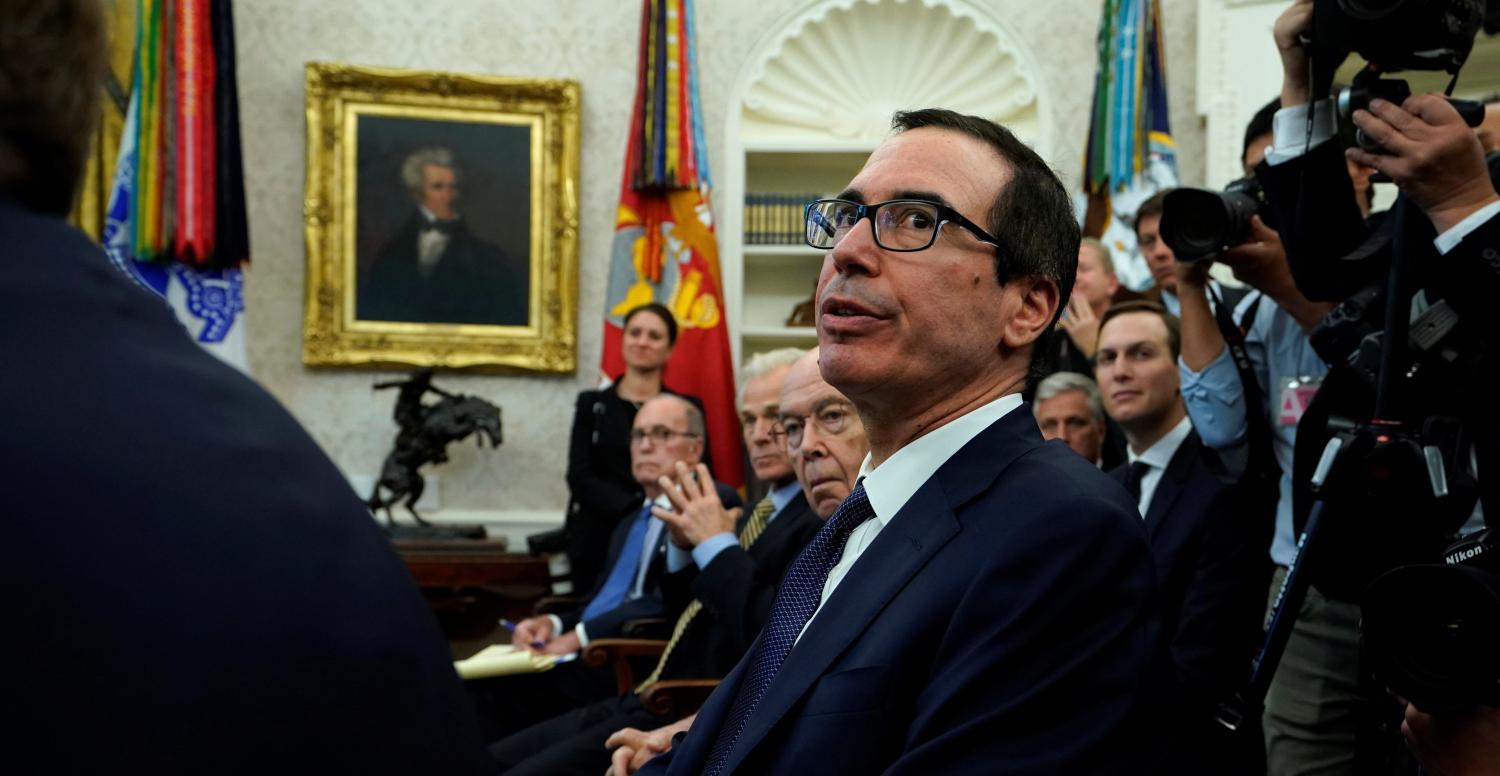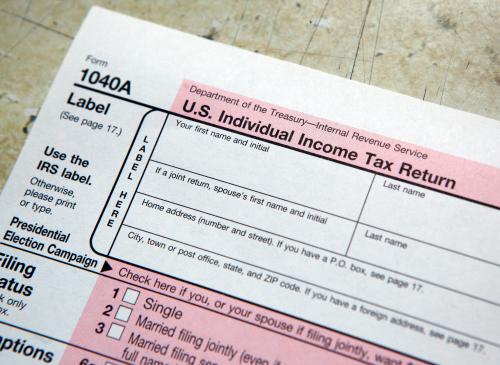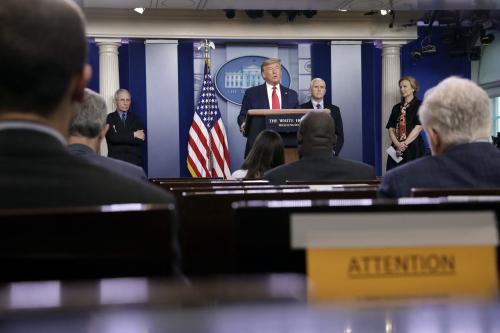This report is part of the Series on Financial Markets and Regulation and was produced by the Brookings Center on Regulation and Markets.
In passing the CARES Act of 2020, Congress created something new under the sun: a Treasury fund of some $454 billion that must be invested in Federal Reserve (Fed) created emergency facilities. America has never seen anything like it. This explainer walks through what this new fund is, what it isn’t, and what the public can expect from these resources as they are deployed.
What Congress Did
Section 4003 of the CARES Act designates $500 billion for the Treasury to use in specific ways. It gives Treasury $46 billion for specific sectoral lending mostly within aviation—$29 billion for airlines and air carriers, $17 billion for “businesses critical to maintaining national security.” Treasury enjoys substantial autonomy with the terms of these funds. The remaining $454 billion has a single purpose for Treasury to use it: “investments in programs or facilities established by” the Federal Reserve.
In other words, Congress just appropriated almost half a trillion dollars for one part of the government to invest in another.
Are there strings attached?
The primary sticking point on this provision between Republicans and Democrats was on what strings, if any, should be attached to this money, or whether it could be deployed subject to either Fed or Treasury discretion.
The result, as is often the case with compromises, is a bit muddled, leaving much to be determined in the regulatory implementation of the statute.
First, in § 4003(c)(1), Treasury can attach “such terms and conditions . . . as the Secretary determines appropriate.” There is some guiding information on the kinds of terms and conditions (such as auditing and the appropriate interest rates that should be charged), but most of those determinations are left to Treasury to decide. This discretion applies to the full $500 billion, not just to the $46 billion in sectoral lending. This is a big stick should Treasury decide to use it
Second, and more concretely, any lending to the three identified sectors left to the Treasury—air travel, air cargo, and national security businesses—is subject to much more extensive if somewhat muddled congressional instruction. In § 4003(c)(2), Congress indicates that the Secretary “may enter into agreements to make loans or loan guarantees to 1 or more eligible businesses” in air travel, air cargo, and national security “if the Secretary determines that, in the Secretary’s discretion,” a number of conditions are satisfied. These include conditions about loan maturity and interest rates, but also some conditions that Democrats favored in the negotiation, including a restriction on equity buybacks (§ 4003(c)(2)(E)), dividends (§ 4003(c)(2)(F)), and a requirement that “until September 30, 2020, the eligible business shall maintain its employment levels as of March 24, 2020, to the extent practicable, and in any case shall not reduce its employment levels by more than 10 percent from the levels on such date.”
These more expansive restrictions are somewhat muddled by the inclusion of the discretion-granting language for Treasury in § 4003(c)(2), that the Secretary should “in the Secretary’s discretion” determine that these conditions are met. But I think a fair reading of the statute would require this sectoral lending to be subject to at least these requirements.
There are also some—but only some—restrictions on the lion’s share of the appropriation, the $454 billion that the Treasury must invest “in programs or facilities established by” the Federal Reserve. Under § 4003(c)(3), Congress created restrictions on the Treasury investments in Fed facilities but only to the extent that such investments are in “direct loans”, not a part of bond- or collateral-purchasing facilities. Those restrictions include limits on stock buybacks, dividends, and executive compensation restrictions. There are no limits on payroll retentions, and unlike the restrictions on the sectoral lending provisions, Treasury can waive these direct-loan restrictions on the $454 billion, § 4003(c)(3)(B)(iii), although such a waiver requires that “the Secretary shall make himself available to testify” before the House Financial Services Committee and the Senate Banking Committee.
How does this fund integrate with the Fed’s existing emergency lending authorities, especially as those evolved after 2008?
Since the Great Depression, Congress has given the Fed emergency lending authority for “unusual and exigent circumstances,” an undefined term. In 2008, the Fed used this authority for the first time since the Depression. In Dodd-Frank, the post-2008 legislative reform signed into law in July 2010, Congress substantially revised this authority by putting all kinds of procedural restrictions in place should the Fed choose to exercise that power. These restrictions include the requirement that the Secretary of the Treasury sign off on any decision to invoke emergency lending authority, that no insolvent company receive emergency loans, that efforts be made to protect taxpayers from losses, and that emergency lending be to participants in a program with “broad-based eligibility”—that is, no lending to a single company.
These rules are still very much in place and not just because the CARES Act does not amend them.
Is Treasury investment in the Fed’s emergency lending necessary?
The Fed has suggested that Treasury investment is necessary because the Fed cannot lose money on its investments, so it needs Treasury participation to be more aggressive in its lending than it is otherwise permitted to do.
But is this correct? Remember that Congress has set the Fed’s emergency lending authority, and that the Fed may only add regulations clarifying that statutory text where permitted to do so by Congress. In other words, Congress sets the agenda for the Fed to implement.
To be very clear: Nowhere in any part of the Federal Reserve Act does Fed lending require Treasury participation, nor did Congress prevent the Fed from taking losses in its emergency lending. Indeed, the Fed returns the proceeds of its interest income after expenses to the Treasury again each year. The curiosity of having one part of the government invest appropriated funds into another part of the government when that second part will be returning its money to the first is itself more than a little dizzying.
The central bankers—and the central bank lawyers—have, however, made much of one provision of the Fed’s emergency lending authority under § 13(3). That is the requirement that any emergency lending be “indorsed or otherwise secured to the satisfaction” of the regional Federal Reserve Bank that undertakes the loan in the first place. As my Brookings colleague Nellie Liang described it, this reality means that how much risk the Treasury is willing to take—especially in its lending through Fed facilities aimed at small businesses—is a “key issue” for the future of the success of this program, given the Fed’s reluctance to be more explicit about what kinds of securities will satisfy it.
To be very clear, though, this statutory restriction is not specific and nothing in the CARES Act changes that. The statute does not dictate any specific kind of lending structure, any specific amount of collateral, or any specific requirement that the Fed avoid taking first losses in an emergency lending facility.
The answer to this apparent conundrum isn’t legal and it isn’t financial. It’s political. This is no small consideration. If the Fed does it’s work right—if it leans into this crisis and makes quick lending decisions in the name of providing much-needed stability—there will be mistakes, there will be losses, there will be idiosyncratic headlines in the local newspaper. Some of these loans won’t work and maybe some of the businesses that take advantage of Fed lending will ultimately be controversial in some future time. The Fed wants cover on these lending decisions. As mentioned, the amended statute already required the Secretary of the Treasury to sign off on any emergency lending programs, in § 13(3)(B)(iv). But the $454 billion provides that political cover with an exclamation point.
The Fed should be clear, though: this Treasury participation was not and is not a legal requirement. The Fed does not need to accept Treasury investment in its emergency facilities and nothing in the CARES Act changes that.
Have we ever seen anything like this before?
No, before the Fed’s coronavirus response initiated Treasury investments like this, this had never been done before, even after the vast experimentation in emergency lending that we saw in the 2008 financial crisis. The closest analogue is the Fed’s original $85 billion 13(3) loan to AIG, followed shortly by more lending and stock purchases by Treasury under TARP. AIG also used other 13(3) facilities to receive more funding from the Fed. All of the other 2008 programs, before the passage of TARP—from the loan to JP Morgan in the purchase of Bear Stearns to the commercial paper lending facilities—were exclusively Fed programs.
The difference between the $454 billion fund and the 2008 interventions, including in AIG, was in the ex ante structuring of these government facilities. Through TARP, both Treasury and the Fed were exposed to the same counter-parties. But once TARP was passed, Treasury took over as the primary counter-party for individual entities.
This new fund now requires a much closer collaboration for Fed and Treasury should the Fed, as now appears likely, make Treasury participation a part of its future lending endeavors. It also puts the Fed in the driver’s seat, since Treasury may invest in only facilities that the Federal Reserve sets up. This raises opportunities of close collaboration between two vital parts of the government’s financial architecture, but also invites pressure on a traditional line between monetary and financial policy controlled by the central bank and the financial, economic, and fiscal policy controlled by the President of the United States and his representatives.
The author did not receive financial support from any firm or person for this article or from any firm or person with a financial or political interest in this article. He is currently not an officer, director, or board member of any organization with an interest in this article.







